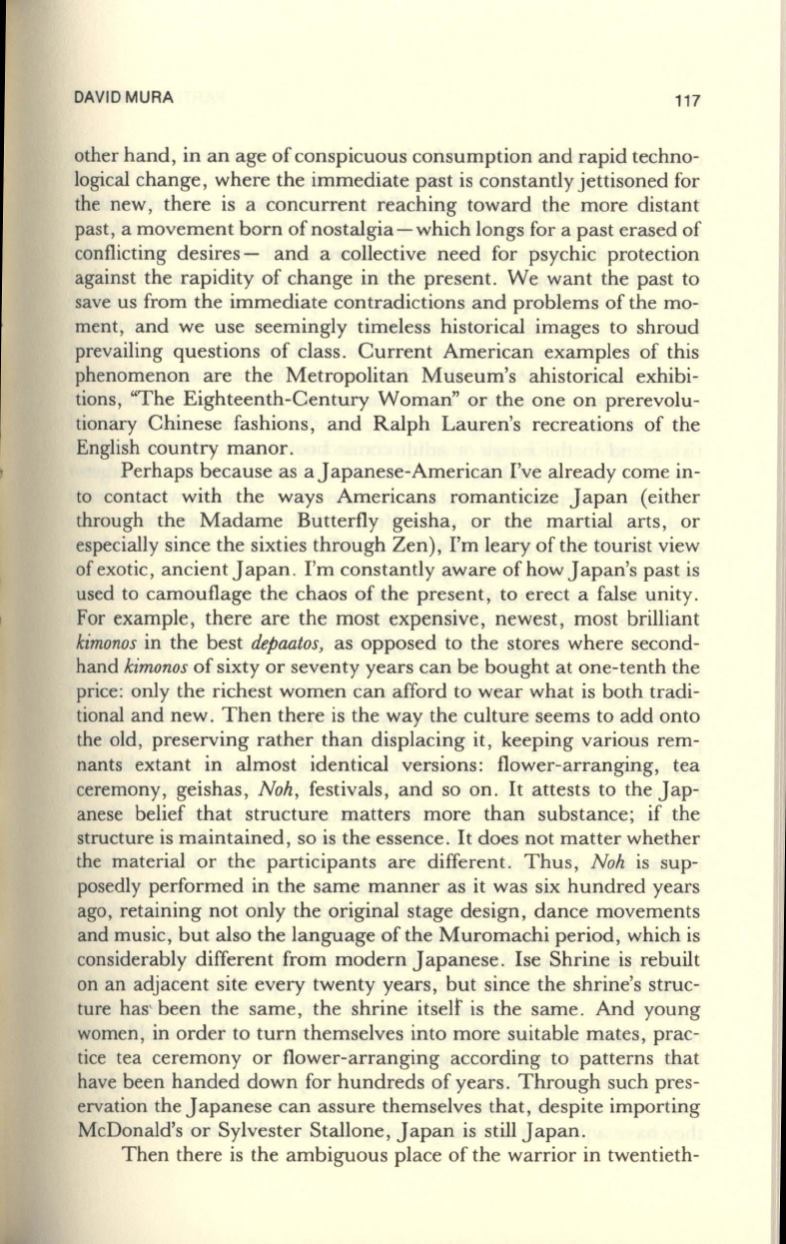
DAVID MURA
117
other hand, in an age of conspicuous consumption and rapid techno–
logical change, where the immediate past is constantly jettisoned for
the new, there is a concurrent reaching toward the more distant
past, a movement born of nostalgia-which longs for a past erased of
conflicting desires - and a collective need for psychic protection
against the rapidity of change in the present. We want the past to
save us from the immediate contradictions and problems of the mo–
ment, and we use seemingly timeless historical images to shroud
prevailing questions of class. Current American examples of this
phenomenon are the Metropolitan Museum's ahistorical exhibi–
tions, "The Eighteenth-Century Woman" or the one on prerevolu–
tionary Chinese fashions, and Ralph Lauren's recreations of the
English country manor.
Perhaps because as aJapanese-American I've already come in–
to contact with the ways Americans romanticize Japan (either
through the Madame Butterfly geisha, or the martial arts, or
especially since the sixties through Zen), I'm leary of the tourist view
of exotic, ancient Japan. I'm constantly aware of how Japan's past is
used to camouflage the chaos of the present, to erect a false unity.
For example, there are the most expensive, newest, most brilliant
kimonos
in the best
depaatos,
as opposed to the stores where second–
hand
kimonos
of sixty or seventy years can be bought at one-tenth the
price: only the richest women can afford to wear what is both tradi–
tional and new. Then there is the way the culture seems to add onto
the old, preserving rather than displacing it, keeping various rem–
nants extant in almost identical versions: flower-arranging, tea
ceremony, geishas,
Noh,
festivals, and so on. It attests to the Jap–
anese belief that structure matters more than substance; if the
structure is maintained, so is the essence. It does not matter whether
the material or the participants are different. Thus,
Noh
is sup–
posedly performed in the same manner as it was six hundred years
ago, retaining not only the original stage design, dance movements
and music, but also the language of the Muromachi period, which is
considerably different from modern Japanese. Ise Shrine is rebuilt
on an adjacent site every twenty years, but since the shrine's struc–
ture has' been the same, the shrine itself is the same. And young
women, in order to turn themselves into more suitable mates, prac–
tice tea ceremony or flower-arranging according to patterns that
have been handed down for hundreds of years. Through such pres–
ervation the Japanese can assure themselves that, despite importing
McDonald's or Sylvester Stallone, Japan is still Japan.
Then there is the ambiguous place of the warrior in twentieth-


